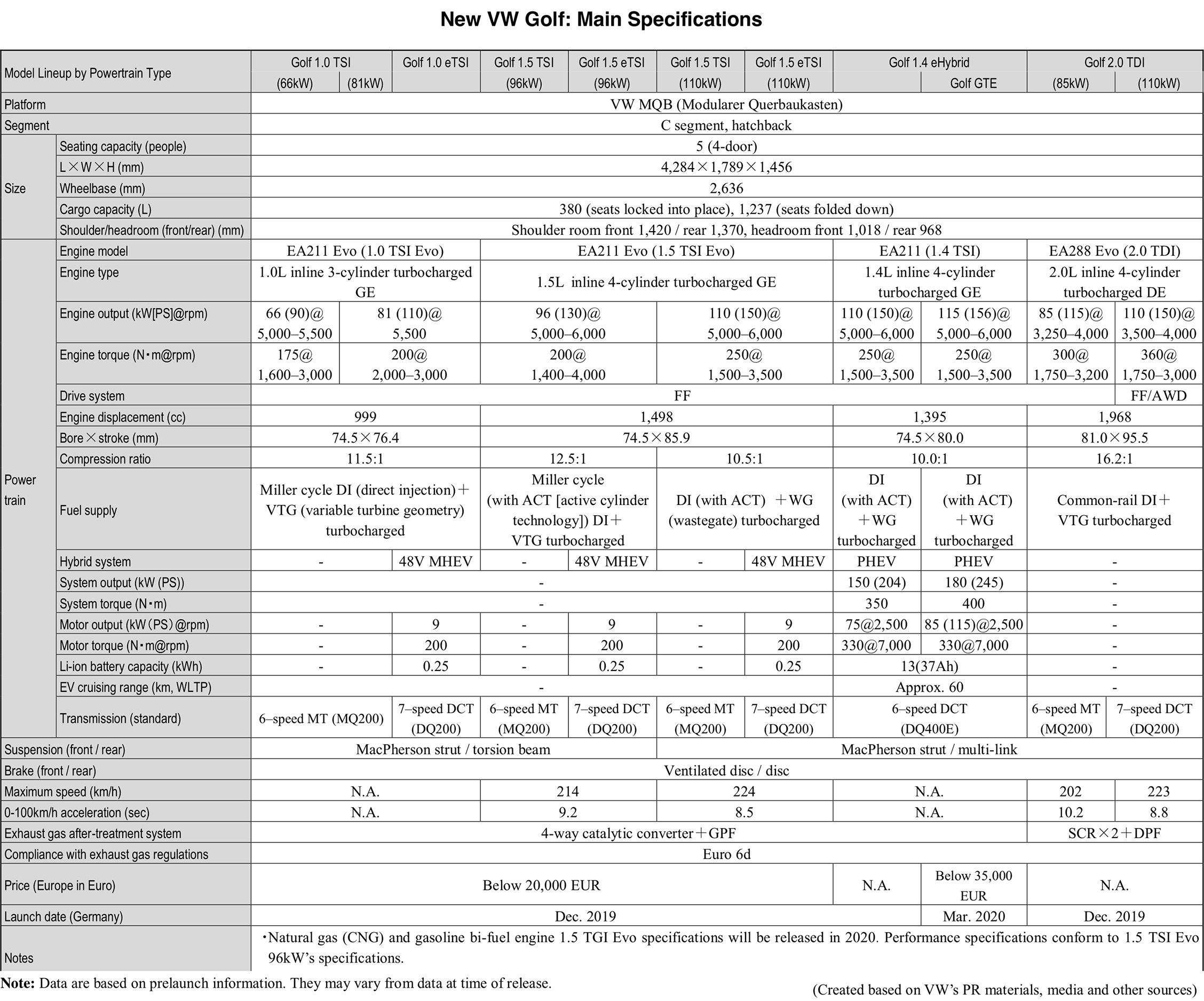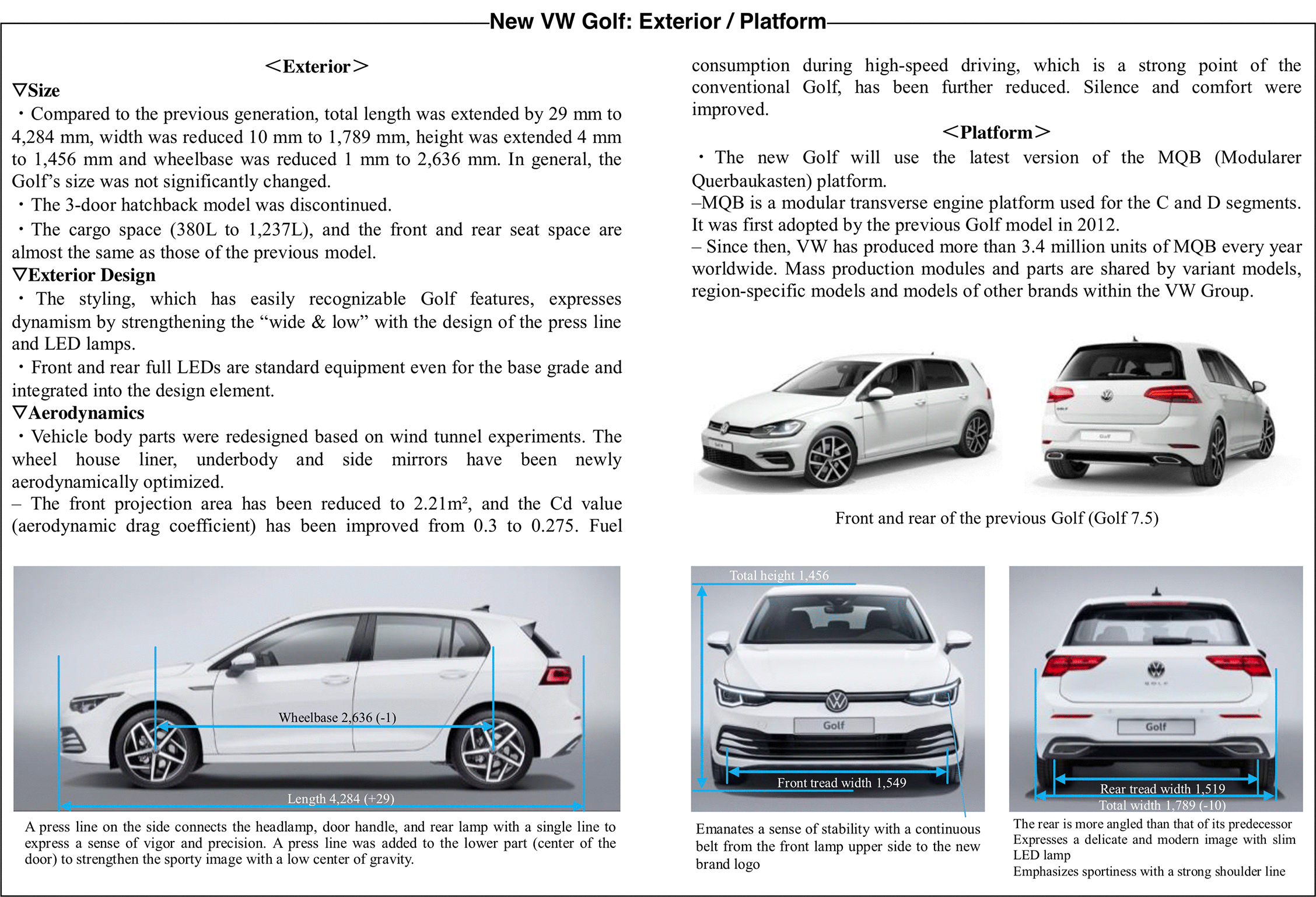AAA weekly
2019-12-16
Copyright FOURIN, Inc. 2025
New VW Golf Features Improved PHEV, Brand’s First 48V MHEV
In October 2019, VW introduced a new C-segment Golf (8th generation) hatchback. The new Golf will be available with a wide range of powertrains, including 48V MHEV and improved PHEV.
While the size of the car is almost the same as that of its predecessor, technical aspects have been significantly renewed of the base grade. It features standardized next-generation functions such as V2X safety equipment using swarm intelligence, connected technology (OCU / eSIM) and fully digital cockpit.
Packaging
The new Golf is based on the latest version of the MQW modular transverse engine platform, which was first adopted in 2012 by the predecessor of the new Golf (Golf 7). Compared to the previous generation, total length was extended by 29 mm and height was extended by 4 mm. On the other hand, total width was reduced by 10 mm and wheelbase was reduced by 1 mm. In general, the Golf’s size was not significantly changed.
Aerodynamics was enhanced. Vehicle body parts were redesigned based on wind tunnel experiments. The front projection area has been reduced to 2.21m2, and the Cd value (aerodynamic drag coefficient) has been improved from 0.3 to 0.275. Fuel consumption during high-speed driving has been further reduced.




Powertrain
Almost all engines of the new Golf have been updated to the latest version.
Low-power gasoline engines with an output of 96kW or less have adopted Miller-cycle combustion process and variable turbine geometry (VTG) to improve efficiency. The diesel models use the latest double AdBlue injection system. They meet Euro 6d emission regulations.
The new Golf is equipped with five types of hybrid powertrains, having the largest number of powertrain systems within the VW brand. The 48V mild hybrid system eTSI is used for the first time under the VW brand. An improved version of the plug-in hybrid model is also available. Daily use is possible with zero-emission driving. It also meets stricter urban low-emission zone (LEZ) requirements.
Chassis
In order to further improve motor performance, the entire chassis has been modified, from software to the mechanism. VW introduced a new central advanced control system to improve the handling of the new Golf. The driving dynamics manager system performs precise chassis control, eliminating the disadvantages of electronic control systems. As a result, neutral behavior and more stable body control can be achieved. Looking at the suspension system, MacPherson strut is equipped in the front and a torsion-beam type or multi-link type in the rear. Improvements have been made in each part, such as the use of high-rigidity aluminum in the front axle sub-frame to reduce weight by about 3kg compared to the previous model. Riding performance, sound and comfort were improved mechanically as well.
Cockpit / Interior
The new Golf features a standardized fully digital cockpit. It is equipped with the latest HMI with an aim for more intuitive operation. The new model is also fitted with online connectivity unit (OCU) with eSIM as standard equipment. Various online services provided by VW are also available. The new Golf also features natural speech recognition capability and integrated Amazon Alexa service.
The interior has been further increased by giving more consideration to materials and finishes as well as by adopting the latest LED lighting technology.
The new Golf is equipped with V2X communication function based on VW’s first swarm intelligence as standard equipment. It offers predictive pedestrian protection and early danger warnings through mutual communication with other vehicles and infrastructure.
The new Golf is equipped with Level 2-equivalent ADAS and Travel Assist. The support system operates at speeds up to 210km/h and combines ACC and LKAS. ACC supports prediction function that uses navigation’s GPS data so-called Level 2+ ADAS. It recognizes traffic sign information using the front camera adjusting to the speed limit.


New VW Golf: Powertrain / Chassis Technology
・The new Golf will be equipped with 5 types of hybrid powertrains (48V MHEV eTSI, PHEV eHybrid) in addition to the conventional model.
・All engines other than 1.4 TSI for PHEV units are the latest engines. In addition, the manual transmission (MQ200) of the conventional model is also new.
Base Engines
1.0 TSI Evo (EA211 Evo)
・An improved version of the 1.0L TSI (EA211) engine, the 1.0L TSI Evo (EA211 Evo), was adopted by the new Golf, becoming the first model to receive this engine within the VW Group. Similarly to the 1.5 TSI Evo (96kW), the new TSI Evo features Miller-cycle combustion process and friction optimized coating.
– The BSG is a carryover from the 1.5 TSI Evo model. For this reason, the design around the crankcase ventilation hole and the oil cooling module were modified compared to the previous generation. It is also designed to be compatible with new PHEV units in the future.
– Output specifications for the new Golf are set at 66kW and 81kW.
1.5 TSI Evo (EA211 Evo)
・The 1.5L TSI Evo (EA211 Evo) is available with 96kW and 110kW output specifications.
– It was first adopted by the minor-change version of the predecessor Golf (commonly known as Golf 7.5, European version) in 2016. It is the latest core engine that replaces the 1.4 TSI.
– The 96kW model uses the TSI Evo Miller-cycle combustion process and. It is also the first mass-manufactured model which is available with variable turbine geometry (VTG).
– The 110kW model is treated with Atmospheric Plasma Spraying (APS) cylinder coating to reduce friction. The turbocharger is equipped with a wastegate valve to regulate maximum boost pressure.
・Both models are equipped with an automatic cylinder deactivation mechanism (ACT Evo) to pursue efficiency.
・Natural gas (CNG) and gasoline combined version of the 1.5 TGI Evo is also available.
2.0 TDI Evo (EA288 Evo)
・VW has newly developed two types of direct-injection diesel engines for the new Golf. Output specifications are set at 85kW and 110kW.
– The version features 4Motion all-wheel-drive technology.
・It is fitted with a new double-dose SCR exhaust gas after-treatment system (AdBlue double injection) compliant with Euro 6d. Compared to the previous after-treatment system, it reduces NOx up to 80% and improves fuel efficiency up to 17%.
・A high-performance GTD with high output specifications will be added in 2020.
Hybrid Powertrain
48V MHEV (eTSI)
・It is the first 48V MHEV system (eTSI) of the VW brand. Based on 1.5 / 1.0L TSI Evo, it combines a 48V belt starter generator (BSG), 48V lithium ion batteries and a DC / DC converter. The engine is available with 81kW, 96kW and 110kW output specifications.
– Fuel economy is improved by up to 10% compared to conventional vehicles (approx. 0.4L / 100km, WLTP).
– Energy regeneration while coasting with completely stopped engine is possible. The motor also assists for re-starting.
・The 48V BSG is supplied by Valeo. A parallel system that functions as both a motor and a generator is integrated with the engine (P0). The 48V BSG is installed in the space of the 12V generator.
– Motor mode (drive)’s maximum output is 9kW and maximum torque is about 200Nm (crankshaft). The generator mode (power generation) has a maximum output of 12kW and energy efficiency of over 85%.
– The 3-phase synchronous motor features P0 arrangement. It controls 16 praseodymium and neodymium permanent magnets and MOSFET power semiconductor with a 12V system. Air cooling is used for cooling.
・The battery has a capacity of about 250Wh and is air-cooled.
・The 48V / 12V DC / DC converter has a rated output of 2.7kW. It is air cooled as well.
・The energy recovery rate of regenerative energy is about 40%.
Please
register or subscribe to view this report for free.
If you’re already a subscriber, sign in.
Credit card information is not needed for free trial registration.
You are eligible to view one report for free.
Additional reports require subscription.







